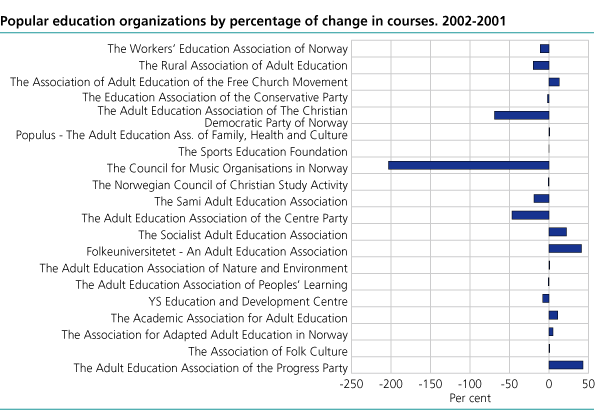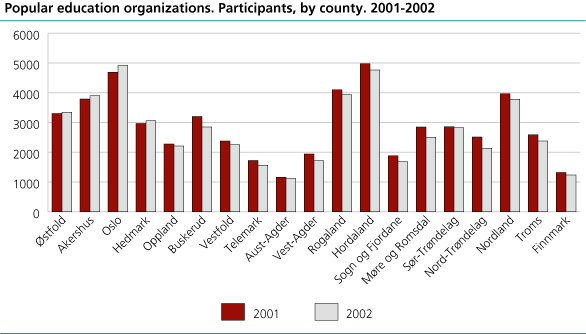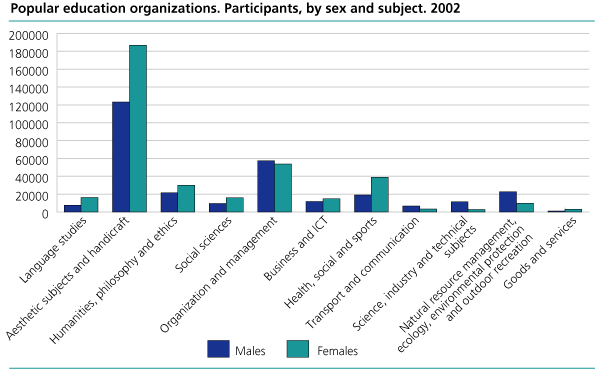Content
Published:
This is an archived release.
More participants despite of less courses
The number of courses arranged by popular education organizations continued to decline during 2002. Even so, more participants were reported than in 2000 and 2001. Fewer courses and more participants meant an average of 13 participants per course, which is higher than ever recorded.
21 popular education organizations reported a total of 52 000 courses, 667 700 participants and 1 730 000 lessons during 2002. Compared with the previous year there were 2 200 fewer courses but 53 000 more participants and 48 500 more lessons. Compared with 2001, courses were down with 4 per cent, while participants and lessons were up with 9 and 3 per cent respectively.
Studieforbundet Folkeuniversitet reported the highest number of courses and participants, 15 000 and 256 000 respectively. Next was Arbeidernes Opplysningsforbund with 8 000 courses and 80 600 participants.
Compared with earlier years, Norsk Musikkråd had a dramatical decrease, while Studieforbundet Folkeuniversitetet had a marked increase during 2002. Norsk Musikkråd reported 7 700 fewer courses and 120 000 fewer participants, while Studieforbundet Folkeuniversitetet reported 6 200 more courses and 170 000 more participants compared with 2001.
Of all popular education organizations, Fremskrittspartiets Studieforbund, which is one of the smallest popular education organizations, had the sharpest increase.
Average number of participants per course the last five years (1997-2001) has been 11. During 2002 the average was 13. Akademisk Studieforbund had the highest average with 43 participants per course, while Samisk Studieutvalg had the lowest average with only 4.
Oslo at the top
During 2002 Oslo had the highest increase in, and number of participants. Oslo had 51 per cent increase in courses and 211 per cent increase in participants from 2001. Next were Sør-Trøndelag and Akershus where participants were up with 17 and 16 per cent respectively. Finnmark experienced the steepest decline, participants were down 13 per cent from 2001.
Women were in majority
56 per cent of all participants in 2002 were female, and most of them were in the age group 30-39. Studieforbundet Populus had the highest proportion of women, 88 per cent, while Fremskrittspartiets Studieforbund had the lowest proportion of women, 29 per cent.
Women were in majority in most subjects; 75 per cent in goods and services, 67 per cent in health, social and sports and 63 per cent in social sciences. In contrast men dominated science, industry and technical subjects were they accounted for 80 per cent of all participants.
The data shows that both men and women continue to choose subject in a traditional manner. Both sexes prefer aesthetic subjects and handicraft. Half of all female participants and 42 per cent of all male participants chose aesthetic subjects and handicraft.
38 per cent of those with reported age were in the age group 30-39. The age group of 50 and above accounted for 36 per cent, while 27 per cent was in the age group 14-29.
Almost 30 000 were given the offer of an exam at university and college level
12 per cent of all participants were offered the possibility of an exam or test. 39 000 were given the option of a public exam, 24 000 were given the option of another valid exam or certificate, while 13 000 were given the option of an internal test. 3000 were given the option of a vocational exam.
Of those who were offered a public exam, 29 000 participated in a course at university or college level, 8000 at upper secondary level.
| 1 | The figures were corrected 06.05.2003. |
Tables:
- Table 1 Number of courses, participants and lessons by organization. 1998-2002
- Table 2 Number of courses, participants and lessons by county. 1998-2002
- Table 3 Number of courses, participants and lessons by subject. 1998-2002
- Table 4 Number of participants by age, sex and county. 1998-2002
- Table 5 Number of partocipant, by age, sex and subject. 2002
Contact
-
Hossein Moafi
E-mail: hossein.moafi@ssb.no
tel.: (+47) 90 40 31 19



